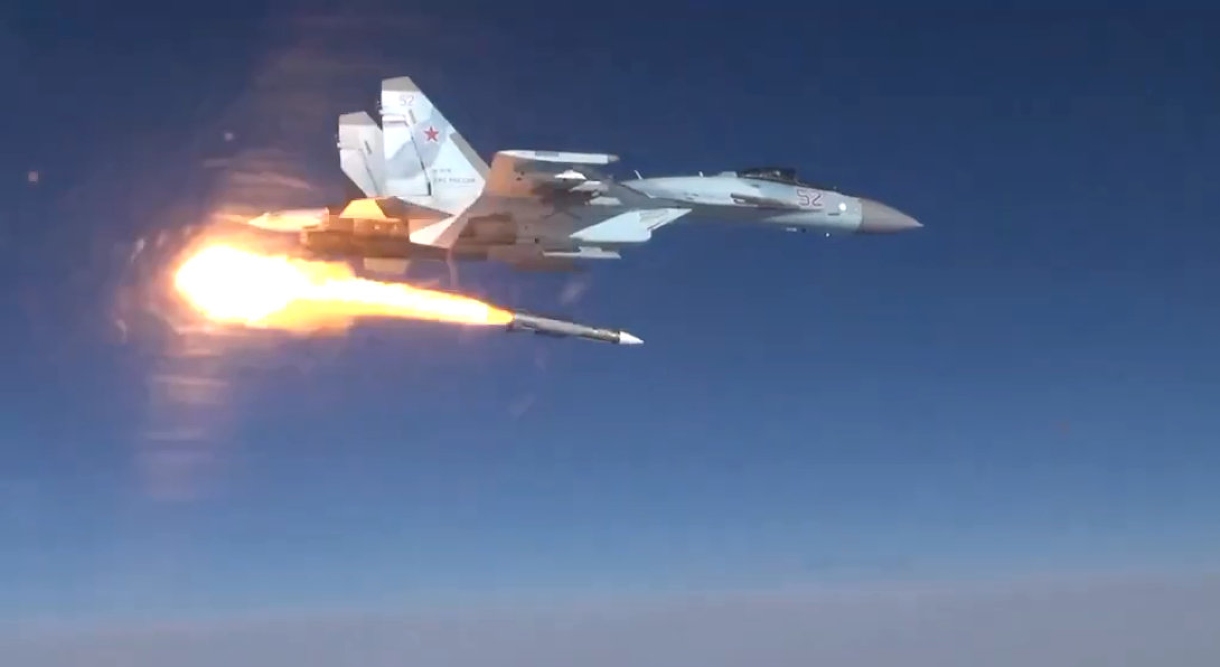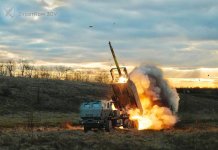On November 18, the Russian Ministry of Defense released a video of the combat maneuvers carried out by the Su-35S crews of the Russian Aerospace Forces against the infrastructure and assets of Ukrainian forces.
Russia’s MoD posted the video on its official telegram channel. The video demonstrates how the Flanker-E performs during combat missions. The Su-35, a feared multirole supermaneuverable fighter, is Russia’s most lethal aircraft in the Ukraine war.
According to the Ministry of Defense, the crew practiced patrolling an assigned location and monitoring the activities of bomber and assault aircraft and army aviation helicopters while conducting air strikes on military installations and hostile equipment.
During the mission, the Flanker-E detected and destroyed an enemy aircraft and a radar station for guided missiles of the S-300 air defense system of the Ukrainian Armed Forces, the MOD said.
Russian state media claimed that the Su-35S proved its worth in Ukraine. Russian Fighter pilots have routinely won air confrontations with Ukrainian pilots and have successfully employed Kh-31 anti-radar missiles to attack enemy air defense sites.
The EurAsian Times had earlier noted that Russian pilots describe the Kh-31 as “Supersonic Death,” claiming that the missile’s tremendous speed and capacity for counterattack make it virtually immune to enemy anti-aircraft defenses. The missile is available in two variants, the Kh-31A and Kh-31P.
The Kh-31A (Active) is a variant of an anti-shipping cruise missile (ASCM) that uses inertial guidance to find its target area. The missile can engage ships displacing up to 4,500 tons.
The Kh-31P is an anti-radiation missile (ARM) version specifically developed to take out active (radiating) adversary radars. It is designed to take down air operations control radars, early warning radars, and medium- and long-range SAM systems.
However, the Su-35 appears to be a crucial part of Russia’s operations in Ukraine based on recent claims made by the Russian MOD. On November 14, Moscow claimed that the Su-35 had recently successfully engaged and downed Ukrainian MiG-29 and Su-25 aircraft.
The aircraft’s performance had earlier been criticized when Ukrainian air defense forces shot it down. Since the start of the war, at least two Russian Su-35 bombers have reportedly been gunned down in Ukraine.
However, Oryx, a group of open-source intelligence researchers who gathered data on aircraft losses in Ukraine through visual documentation, noted that Ukrainian forces shot down only one Su-35.

Su-35 Fighter Jet
The Sukhoi Su-35 is a multipurpose air superiority fighter with increased capabilities that evolved from the Su-27.
The Sukhoi Su-35S is equipped with a 30mm gun, 12 hardpoints, and a radar that can simultaneously track up to 30 targets. It can also identify targets at a distance of over 400 kilometers.
Without refueling, the fighter has a range of more than 3,500 kilometers. The standout characteristics of this powerful 4++ Generation fighter include improved engines, avionics, and radar.
The Sukhoi Su-35 jets are significantly different from their forerunners, the Su-27 family of jets, — they use high-thrust engines. The new engines, which go by the designation 117S, were developed by NPO Saturn, a UEC affiliate.
The new jet’s avionics is an entirely new system of onboard electronics. The complete Sukhoi Su-35 electronics suite is housed in a single system.
Despite not having an APAR (active phased array radar), the Su-35 radar system can monitor and engage up to eight airborne targets simultaneously and detect targets up to 400 kilometers away.

The Ryazan State Instrument Factory manufactures the radar system, initially designed by the Tikhomirov Instrument Engineering Research Institute.
The aircraft is equipped with friend-or-foe identification capability for aerial and maritime objects. It can also recognize the class and type of airborne targets and take aerial photos of the ground.
The system can be deployed at any time of day and in any weather. It maintains its effectiveness in the face of interference from natural factors and adversary electronic warfare systems.
The aircraft’s electronic warfare suite consists of a chaff and flare dispenser, a missile approach warning system, a laser warner, a radar warning system, and a cooperative radar jamming system.
- Contact the author at ashishmichel@gmail.com
- Follow EurAsian Times on Google News




